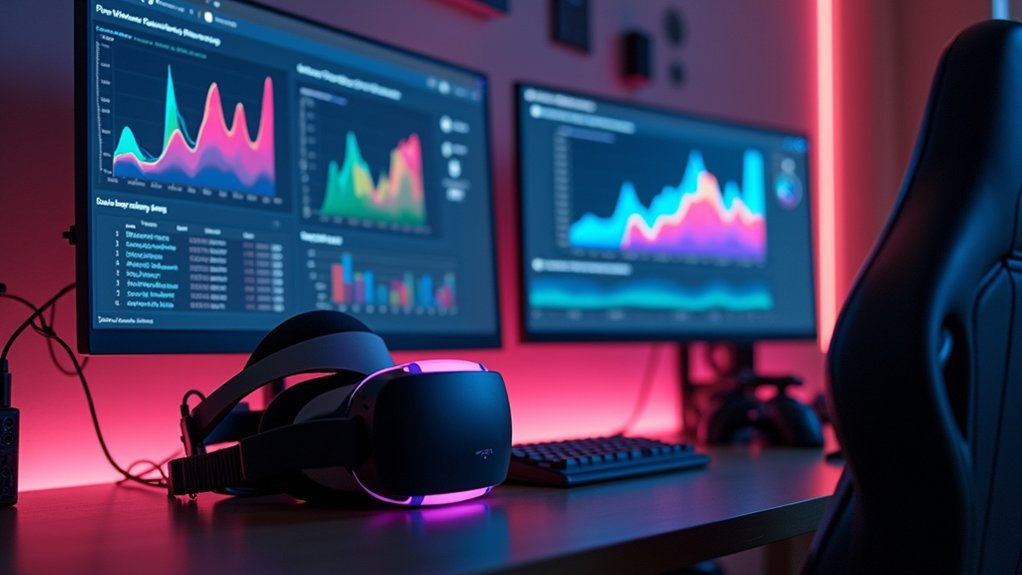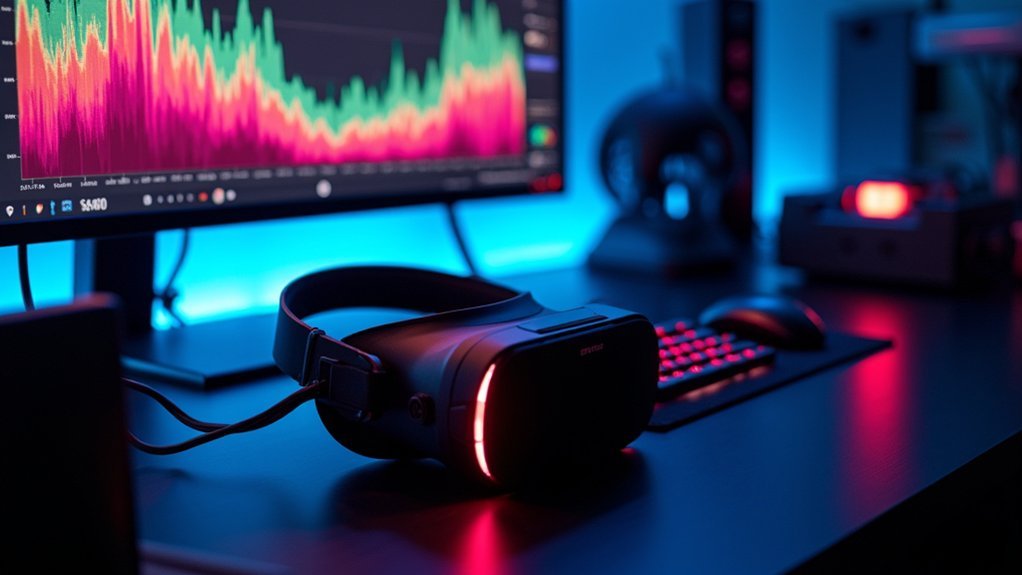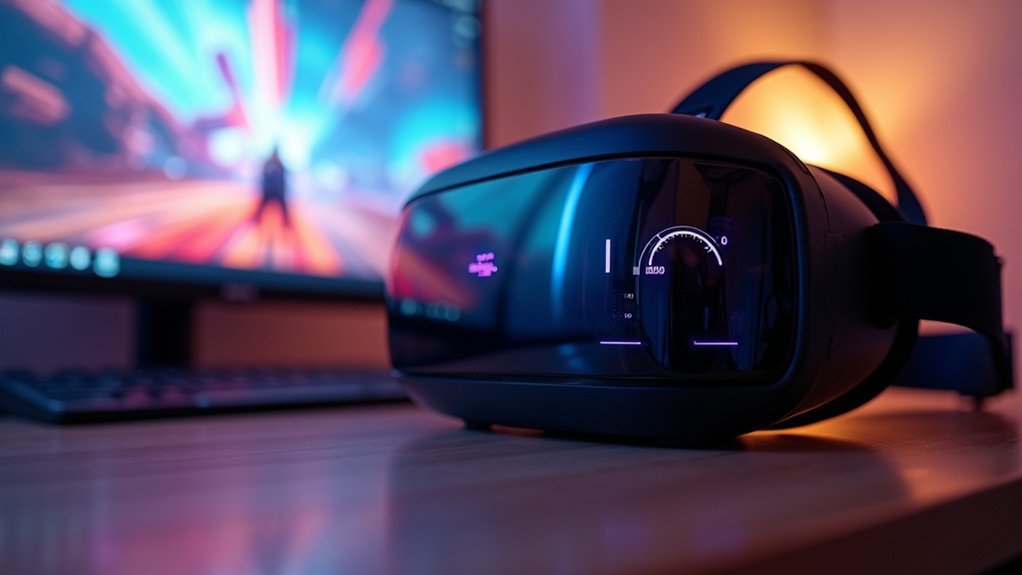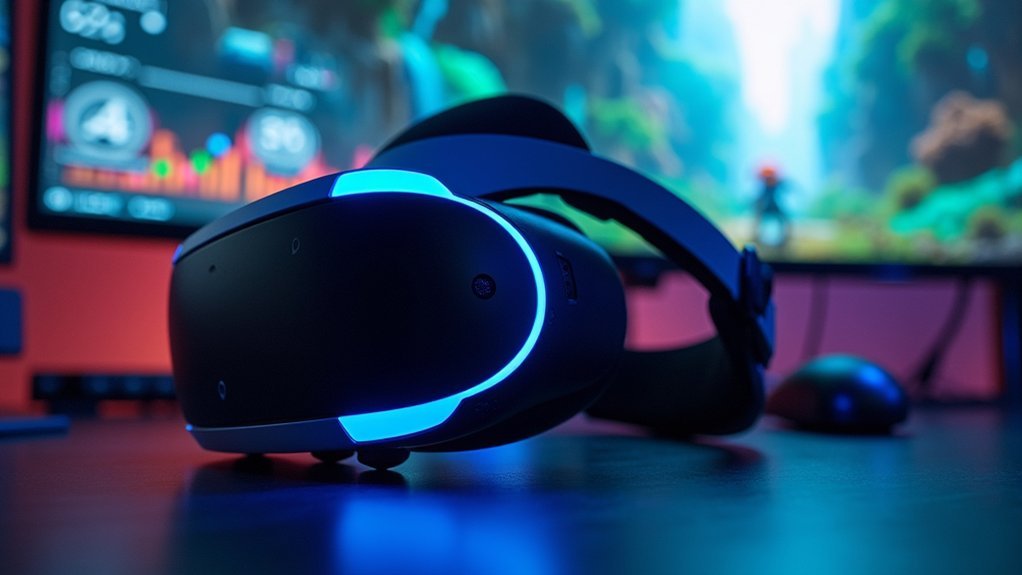Your SteamVR performance test results determine whether you’ll enjoy smooth 90 FPS virtual reality gaming or suffer through stuttering, motion sickness-inducing frame drops. These fidelity scores ranging from “Very High” to “Low” reveal your hardware’s ability to maintain consistent frame times below 11.1 milliseconds, which is essential for immersive VR experiences. Poor performance results indicate you’ll face compatibility issues, thermal throttling, and system bottlenecks that can completely ruin your gaming sessions and investment in VR technology.
Understanding SteamVR Performance Test Metrics

When evaluating your system’s VR capabilities, the SteamVR Performance Test doesn’t rely on traditional frame-per-second measurements but instead uses Average Fidelity scores that range from “Very High” to “Low.”
These scores reflect your hardware’s ability to maintain the quality and detail of VR environments while hitting the critical 90 FPS target that’s essential for smooth, nausea-free virtual reality experiences.
Understanding these metrics helps you make informed decisions about your Steam VR setup.
The test primarily evaluates GPU performance, which can create misleading impressions about your system’s overall readiness.
GPU-focused testing can give you false confidence about your system’s true VR performance capabilities.
You’ll need to take into account factors beyond just graphics processing power, as CPU performance and other components greatly impact your actual VR gaming experience despite the test’s GPU-focused approach.
CPU Performance Impact on VR Gaming
While GPU performance dominates the SteamVR Performance Test results, your CPU’s role in VR gaming presents a more nuanced picture than these scores suggest.
When testing different Intel CPUs, you’ll notice minimal performance differences and nearly identical fidelity scores. This doesn’t mean your CPU performance is irrelevant—the SteamVR test simply emphasizes GPU-intensive rendering over CPU-heavy tasks.
The dual-environment rendering requirements in VR create scenarios where CPU limitations don’t manifest as strongly as traditional gaming benchmarks. Your processor remains important for VR builds, handling background processes and system management.
However, current testing methods may not fully capture CPU performance impact. As VR applications evolve to demand more computational power, your CPU’s influence on performance will likely become more pronounced than these current assessments indicate.
GPU Performance Analysis Across Price Points

Unlike CPU performance where differences remain subtle, GPU selection dramatically impacts your VR experience and requires careful consideration of price-to-performance ratios across different market segments.
NVIDIA graphics cards typically dominate the high-end market, while AMD excels in mid-range offerings. You’ll find that cards like the Titan X and Fury X deliver comparable performance within their price brackets, making your choice dependent on specific budget constraints.
However, you shouldn’t assume expensive means better value. Higher-end GPUs show diminishing returns in VR fidelity scores, meaning you won’t always see significant improvements from top-tier models.
Overclocking provides modest gains of about 0.2 points average increase. Multi-GPU setups like SLI or Crossfire offer minimal benefits, so focus on single-card performance instead.
Multi-Card Configuration Results
You’ll find that multi-GPU setups don’t deliver the performance boost you’d expect in VR applications.
SLI configurations with GTX 980s barely utilize the second card, while Crossfire setups with R9 Fury Xs show only marginal improvements.
Your motherboard’s PCI lane bandwidth becomes essential here, as platforms like X99 can fully leverage Crossfire capabilities unlike Z170 systems.
SLI Performance Gains
When you’re considering a multi-GPU setup for VR gaming, the SteamVR Performance Test reveals disappointing results that’ll likely change your purchasing decisions.
The harsh reality is that SLI configurations provide minimal VR Performance improvements:
- Your GTX 980 SLI setup won’t deliver any notable fidelity score improvements compared to a single GTX 980.
- AMD’s Crossfire performs slightly better, with dual R9 Fury Xs achieving just a modest 1-point fidelity increase.
- Your motherboard’s PCI lane bandwidth considerably impacts results—X99 platforms outperform Z170 configurations.
- Multi-GPU setups create more complexity without meaningful VR Performance gains.
- Single high-performance GPUs consistently deliver better value than dual-card configurations.
You’re better off investing in one powerful GPU rather than dealing with SLI’s compatibility issues and lackluster performance benefits for VR applications.
Crossfire Recognition Benefits
AMD’s Crossfire technology receives better recognition in SteamVR Performance Test compared to NVIDIA’s SLI implementation. You’ll notice crossfire recognition benefits when running dual R9 Fury X cards, achieving modest fidelity score improvements of approximately 1 point. However, your motherboard’s PCI lane bandwidth notably impacts these gains.
| Platform | Crossfire Performance |
|---|---|
| X99 | Full utilization |
| Z170 | Limited capability |
Your graphics card configuration matters, but don’t expect dramatic improvements. The performance gains aren’t universally applicable across all hardware combinations. While SteamVR acknowledges your dual-GPU setup, the test emphasizes evaluating overall system performance rather than simply counting GPUs. You’ll find that crossfire recognition benefits remain minimal, suggesting multi-GPU configurations don’t considerably enhance VR readiness scores in practical scenarios.
Platform Bandwidth Impact
Although multi-GPU configurations promise enhanced VR performance, your motherboard’s PCI Express lane distribution creates significant bottlenecks that limit actual gains.
Your platform choice directly impacts whether you’ll achieve VR Ready performance with dual graphics cards. The bandwidth differences between motherboard architectures create varying results:
- X99 platforms provide better dual GPU utilization through superior PCI lane allocation
- Z170 configurations struggle with bandwidth limitations that handicap second GPU performance
- Lane distribution affects how effectively your system can communicate with multiple graphics cards
- Bottlenecking occurs when insufficient bandwidth prevents proper data flow between components
- Future VR applications may better leverage available bandwidth as optimization improves
Current SteamVR Performance Test results demonstrate that your motherboard’s architecture plays a vital role in determining whether multi-GPU investments deliver meaningful performance improvements for VR gaming.
Overclocking Effects on VR Performance
You’ll find that overclocking your GPU provides measurable performance gains in SteamVR testing, typically improving fidelity scores by around 0.2 points above stock settings.
Multi-GPU configurations add another layer of complexity to overclocking considerations, as you’re managing thermal loads and stability across multiple cards simultaneously.
You must carefully monitor temperatures and system stability throughout your overclocking process, since VR’s demanding 90 FPS requirements leave little room for thermal throttling or crashes.
GPU Overclocking Performance Gains
Overclocking your GPU can squeeze out additional performance in VR, though the gains you’ll see are modest rather than revolutionary. When testing gpu overclocking performance gains in the SteamVR Performance Test, you’ll typically observe an average fidelity score increase of approximately 0.2 points compared to stock settings.
Here’s what you should expect from GPU overclocking in VR:
- Factory overclocked cards show slight fidelity score improvements over reference models
- Performance gains follow similar patterns to traditional gaming benchmarks
- Temperature monitoring becomes vital to prevent thermal throttling
- System stability requires careful tuning and testing
- Marginal improvements may not justify potential risks of overheating
While overclocking can enhance your VR experience, the differences remain relatively small, making careful consideration of risks versus rewards essential.
Multi-GPU Configuration Impact
While single GPU overclocking delivers modest gains, multi-GPU configurations present a more complex picture in VR performance testing.
You’ll find that SLI and Crossfire setups don’t translate to significant VR performance improvements in the SteamVR Performance Test. When you’re running dual GTX 980s in SLI, the second GPU remains largely underutilized, producing negligible performance differences compared to single card configurations.
AMD’s Crossfire technology doesn’t fare much better.
You’ll see only a 1-point improvement in average fidelity scores when pairing two R9 Fury X cards. This minimal gain suggests that current VR benchmarks can’t effectively leverage multi-GPU configurations.
However, you shouldn’t write off these setups entirely, as future VR applications may better utilize dual-card configurations.
Temperature and Stability Monitoring
Although overclocking your GPU can deliver modest VR performance gains, maintaining proper temperature control becomes critical for sustained results.
You’ll see those 0.2-point fidelity improvements in SteamVR Performance Test, but only if you’re monitoring temperatures closely to prevent thermal throttling.
Your system’s stability depends on consistent performance metrics:
- Monitor frame times to stay at 11.1 milliseconds or less for 90 FPS VR
- Use MSI Afterburner for simple adjustments without extensive overclocking
- Install multiple fans or enhanced cooling pads for ideal temperature management
- Watch for thermal throttling that can negate overclocking benefits
- Verify stability through sustained gaming sessions rather than brief tests
Without proper cooling solutions, increased power usage from overclocking will raise operating temperatures and compromise your VR experience.
Frame Time Requirements for Optimal VR
Why does achieving consistent frame time matter so much more in VR than traditional gaming?
You’re rendering two separate environments simultaneously, doubling the computational demand compared to standard displays. To maintain ideal VR performance, you’ll need frame times of 11.1 milliseconds or less, achieving that vital 90 frame rate threshold.
Frame time variability becomes your worst enemy in VR. While traditional gaming tolerates occasional stutters, VR punishes inconsistent performance with motion sickness and discomfort. You’ll experience noticeable lag when frame times spike, breaking immersion instantly.
Inconsistent frame times in VR trigger motion sickness and shatter immersion, making smooth performance absolutely critical for player comfort.
Monitoring frame times gives you important insights into your system’s performance bottlenecks. You can identify hardware limitations, thermal throttling, or software conflicts before they ruin your VR experience.
Stable, low frame times aren’t just preferable—they’re indispensable for comfortable VR gaming.
System Optimization Techniques

Since your VR experience depends heavily on consistent frame delivery, you’ll want to start with fundamental system optimization techniques that maximize your hardware’s potential.
These adjustments can dramatically improve your VR applications’ performance.
Essential system optimization techniques include:
- Update everything – Keep your operating system and GPU drivers current, then restart your system to clear RAM and processor cache
- Configure Nvidia Control Panel – Set power management to “prefer maximum performance” and texture filtering to “high performance”
- Adjust game settings – Lower in-game settings and monitor resolution to maintain consistent 90 FPS
- Overclock your GPU – Careful adjustments can yield 0.2 point fidelity increases in SteamVR tests
- Use SSDs – Install games on solid-state drives to reduce loading times and prevent data transfer delays
Hardware Bottlenecks and Compatibility Issues
Even with proper system optimization, hardware bottlenecks can greatly limit your VR performance and create compatibility issues that prevent you from achieving smooth gameplay.
While SteamVR Performance Test shows CPU impact is negligible compared to GPU performance, an outdated processor can still restrict your powerful graphics card’s potential when running demanding VR content.
An outdated CPU can bottleneck even the most powerful graphics cards when running demanding VR applications.
You’ll face compatibility problems with older motherboards that have limited PCI lane bandwidth, especially when attempting multi-GPU setups like Crossfire or SLI.
Your overclocking efforts might yield small performance gains, but you must verify your entire system supports these enhancements without creating new bottlenecks.
Installing VR content on SSDs rather than traditional hard drives considerably reduces loading times, preventing performance delays that compromise immersion.
Frequently Asked Questions
Is Openxr Better Than Steamvr?
You’ll find OpenXR offers better cross-platform compatibility and hardware flexibility, while SteamVR excels within Valve’s ecosystem. Choose OpenXR if you’re using diverse hardware; pick SteamVR if you’re Steam-focused.
What Is a Steamvr Performance Test?
You’ll use SteamVR Performance Test to evaluate your system’s VR capability. It measures your hardware’s ability to maintain 90 FPS and assigns fidelity scores from “Very High” to “Low” for ideal VR performance.
Why Is My Steamvr Not Running Smoothly?
Your SteamVR isn’t running smoothly because you’re likely experiencing high frame times above 11.1ms, outdated drivers, CPU bottlenecks, or resource-heavy background apps affecting your system’s VR performance.
What Are the Best Settings for VR Performance?
You’ll want to lower in-game settings first, then adjust Nvidia Control Panel to “prefer maximum performance.” Update GPU drivers regularly, restart your system frequently, and install games on SSDs for peak VR performance.
In Summary
You’ll find that SteamVR performance metrics directly impact your gaming experience through frame time consistency and visual fidelity. When you’re optimizing your CPU and GPU combination, you’re ensuring smooth gameplay without motion sickness-inducing stutters. Don’t overlook system bottlenecks that’ll compromise your VR sessions. By understanding these performance factors, you’re making informed hardware decisions that’ll deliver the immersive gaming experience you’re seeking. Your investment in proper VR-ready components pays dividends in gameplay quality.





Leave a Reply